| |
“The opening line in the synopsis: “Someone pulled the head off of Mrs. Murphy’s cat.” The idea that an animal could be acting like a man acting like an animal. An ironic spin on Michael Myers and the whole genre. Then learning from Jane Goodall that there was some truth to this idea…” |
| |
Director Richard Franklin, asked what drew him to the project from
John Kenneth Muir’s Reflections on Cult Movies and Classic TV* |
Link the movie is as idiosyncratic as Link the lead simian character. The film is bolstered by the then relatively recent revelations that chimps could not only be as barbaric as human beings but that they were also physically much stronger than we were. The filmmakers take these ideas and from them produce a quirky, gothic suspense piece that has its genuinely shocking moments. Something is scaring children and laying waste to fellow creatures on the rooftops of London. At the London College of Sciences, American student Jane Chase arrives for a lecture where Dr. Steven Phillip is expounding some of these newfound theories with his young chimp, Imp. Catching up with him afterwards, Jane volunteers to help with the good doctor’s primate care in Scotland. There, she is introduced to Link, an older, ex-circus chimp (more on this animal’s confusing physicality a little later) who acts like a loyal retainer seeing Jane, butler-like, to her room. Dr. Phillip introduces Link’s party trick, lighting and smoking a cigar while Jane looks on disapprovingly. “Link! Master of fire!” There follow several power plays in and around the cliff top coastal mansion with Link slowly but steadily getting the upper hand… Let’s just say a primate civil war is hatched and put into play…

In 1986, you could count leading screen heroines on the finger of one hand; Ellen Ripley. Full stop. And even that character was written as a man before Walter Hill came on board to rewrite the genre-defining Alien. You might argue for Princess Leia Organa and indeed Sarah Connor but I’m sticking with Ripley, a character on whose single pair of shoulders three more franchise movies would be placed. Link stands out in this regard by letting its young leading lady carry most of the film. The character of Jane is more resourceful than everyone else and in all the obvious ways (I mean, this is why film stars are film stars) Elisabeth Shue is a delight to watch. She’s since proved her talent in numerous other projects, notably Leaving Las Vegas for which she was Oscar nominated, but here, her youth and vitality shine out and the film rarely makes too many demands on the untapped potential of what she proved she was subsequently capable. Watching her performance in The Boys, it’s clear the actress is still up for taking risks in her chosen profession. Bravo. Terence Stamp, another actor blessed with lottery-winning DNA, plays Dr. Phillip as an affable alpha male given that he has to keep three chimps in check. As odd as it sounds talking about an iconic actor of his generation but Stamp is probably best known as General Zod in the Richard Donner Superman movies. His early work is no less impressive as I noted in my review of The Collector. But as “Kneel before Zod!” has rightly gone viral as a movie meme of sorts, Stamp will always be Zod first. It was lovely to see him turn up as the senior bearer of the subtle knife in the BBC’s His Dark Materials a few weeks ago.
Of the three students who pitch up at Phillip’s mansion after the telephone line was ripped out by a smart primate, two went on to have steady careers in film and TV right up to today. Steven Finch as Tom, Jane’s semi-boyfriend, is well known to UK TV audiences. He was credited as Steven Pinner but changed his name to Finch while on his stint on Brookside as a fellow actor, Steven Pinder, had a too similar sounding name. David O’Hara as Tom has also thrived in the industry, notably as Jack Nicholson’s hard as nails lieutenant in Scorsese’s The Departed. But for high profile parts, not many could beat O’Hara playing Runcorn as the identity a certain Harry Potter borrowed in Harry Potter and the Deathly Hallows Part 1. Richard Garnett as Dennis dropped out of acting in 1998 after a few higher profile parts.
So, cast-wise, let’s address the mammoth in the room and, as is a mammoth’s wont, it’s a big hairy one. It is all too obvious that the eponymous lead chimpanzee is nothing of the sort. It’s clearly an orang-utan with prosthetic ears and dyed black fur. If that’s a spoiler, I humbly apologise. The character of Link therefore has some severe plausibility issues to overcome but what is so astonishing is that Link (or Locke to give him his stage name) does in fact give a spirited performance, lugubrious almost and despite the chimpanzee wannabe efforts of make-up and hair, his real self becomes less of a problem in the actual story. Link is a very odd creature and often behaves in a contradictory manner so what I’m saying is that Link is Link and you soon learn to accept this. A man in a suit would not have cut it (although a stunt person in a suit takes the brunt of the violence and performs the fast action). It’s Locke’s way of walking which is always the giveaway as to who’s on screen. Orang-utan’s curl their feet and angle them ninety degrees inwards when moving on the ground so it looks like they are walking on fists. The greatest contortionist in the world - never mind stunt person - would have a problem with that manoeuvre. Yes, the curled feet have been recreated as fake shoes for the stand-in but once or twice you catch a glimpse of ‘normal’ feet movement.

Of the two other real chimps in the movie, one is notable for being full-grown. Fully grown chimps are extraordinarily dangerous and even the youngsters can cause significant havoc if they felt like it. I’ve worked with chimps myself and when you hold them balanced on your hip, you are instantly aware of the density of their muscles. They are twice as heavy as you think they are (which is why they can’t swim) and you can bounce coins off them, they are so naturally ripped.
I have to mention master animal trainer Ray Berwick. He trained the birds for a Hitchcock film, the name of which escapes me at the moment. He brought out micro performances from his animals that, more often than not, were shot at a higher frame rate to slow their actions down. The editor can do a great deal with an eyebrow raise or a leisurely look to the side. It was less of a directorial command shooting them and more of a turn over and hope and let the editor find that perfect moment. Berwick was an unassuming man with a remarkable command of and rapport with his animals. Of course now, Link would be created as a computer generated character and possess the smallest fraction of Locke’s fur-dyed charm. And this singular animal has no problem being the primary focus of the film. It’s a stretch to convince us of his great strength and viciousness (baring teeth is not the same as snarling in rage) and his unerring ability never to be visible in places out from which his arm suddenly springs is suspect but he’s such an extraordinary and real character so Locke deserves all the plaudits thrown his way.
Franklin’s grip on the film is tight and Andrew London’s editing is meticulous and compliments Franklin’s style of suspense. If you notice that the shot of the car keys is upside down at 1 hour, 28 minutes and 8 seconds, you’re not going mad. I remember asking Andrew why he did that and I’ve forgotten his answer so it’ll have to remain a small mystery. The siege at the climax is a real nail-biter urged along by Jerry Goldsmith’s driving, circus themed score. The great composer is in full Gremlins mode using the same distinctive synthesizer sound for Link that served Gizmo and pals in the 1984 movie. Richard was concerned that the film was too fragmented but Jerry was taken with Link himself and created a score that is just as nuts as the film. Richard remarked in his LP notes that “Jerry Goldsmith brought Link to life!” There’s no doubt the music unifies a lot of the sequences that may not have played as well without the score.

It may be interesting to note that the most important scene in this idiosyncratic little thriller, according to Richard, had nothing to do with thrills, suspense or horror. It was the scene highlighted by Film Programmer and Horror Expert Anna Bogutskaya in the last Extra on the disc. The subtext, philosophy and evolutionary musing you could write about as the naked ape (Jane) is ogled by a partially dressed real ape (Link) as she prepares to take a bath, would run to reams. It should feel exploitive but it is a fascinating scene with a real profound idea at its core. Elisabeth Shue’s body double Jayne Grosvenor in the key wide shot utterly convinces. In a small but fun moment, look at Link’s absorbed face as Jane puts her robe back on. He gets a proverbial slap from the movement of the robe’s arm, one of those astonishing ‘accidents’ that happen now and again shooting movies.
On the down side… Richard credits back projection as a lifesaver on Road Games. He’d still be filming today if he’d had to shoot Stacy Keach in his cab driving for real. Rear projection was forced on Richard on Link shooting any ‘exterior’ scenes with the trained apes as they were under strict quarantine rules. Yes, the house exterior and interior was all one large set so that was a safe space for the animals. It’s my long relationship with cinema that makes me just too sensitive to this rear projection effect. There are a few matte lines that are very obvious and the matte painting of the gutted house is not as convincing as it could be. As two characters fall to their deaths, the nature of the dummy seen for a short time used for the first and the dummy with optical superimposition used for the second are rather obvious. Link was shot a year after extremely realistic dummies (with correctly flailing limbs made by effects supervisor George Gibbs) were made for the rope bridge scene in Indiana Jones and the Temple of Doom. It always surprised me why that simple technology had not been employed before as dummies being filmed falling almost never used to work in movies and always took me out of the story.
Director Richard Franklin, despite the film’s lesser moments, always had an overview on how he wanted the audience to respond to his work. When Link didn’t easily slot into anyone’s idea of a rigidly defined ‘horror’ or ‘thriller’ or ‘suspense’ movie, it was almost doomed from the get-go. This is how cults begin and I truly hope this extraordinarily odd little film will enjoy its cult status for as long as possible. My role in its making was comparatively small. The effect of its making on me was enormous and reverberates to this day. More on that experience, coming right up.
A Few Recollections on the Making of Link…
| |
"It was a grindingly difficult shoot. But not because of the apes. I found the English crew very slow and difficult.” |
| |
Director Richard Franklin* |
As a nod to the original title of Casablanca, everything starts with Rick. By 1985, in the lowliest of capacities, I had worked on two feature films. The second, Dream Child, was an affecting drama centred on Lewis Carroll’s muse as an old lady visiting New York in the 30s. I was assisting director Gavin Millar whom I’d got to know from letter writing in the late 70s. The co-producer was American Rick McCallum who’d made the movie remake of Pennies From Heaven in the US and he and Dennis Potter struck up what seemed to me to be a very odd partnership. Potter was a brilliant writer, known to fiercely defend the integrity of his work and he was often ripped apart in the English press, sometimes personally, by certain critics who objected to his view of the world. He was often laid low by his crippling arthritis and horrendous skin psoriasis. McCallum was (and still is, I blithely assume) an effervescent American, as charismatic as a log fire, a born storyteller and just the most exuberant and entertaining company.
 |
 |
| Rick McCallum, yours truly and Gavin Millar on Dream Child (1985) |
After Dream Child, he had me ‘break down’ each episodic script of The Singing Detective (which meant prepping each scene, dividing into day/night, interior/exterior etc. so the shoot could be planned). I still have the last episode’s script that contains Potter’s original ending, very different to the actual filmed one. I was in Rick’s office at Shepperton Studios, probably delivering my work, when I heard an Australian voice behind an office door. I asked Rick who it was. “Oh, that’s Richard Franklin, pitching a thriller to EMI.” Well, I had been with a group of critics who’d all applauded at the end of Psycho II at a press screening so I just had to introduce myself and say hello.
Richard was courteous and receptive of my praise (but then again, who’d baulk at praise of any kind?) and when the subject of his assistant on the next film came up, I threw my hat into the ring. Richard answered my enthusiasm with a line that no one would dare utter today… “Well, my assistant’s usually a girl.” I supposed my pre-tested relationship with his new American co-producer may have helped but I was hired and thrashed around in the world of ‘important people’ for quite a few months before I found my feet and managed to face the right way. The cliché of my own life that I have told so many friends too often is that my time on Link gave me the most useful, if not comfortably enjoyable, lessons on what being a human being was really all about. On the film, I witnessed the extremes of human emotion and almost, it seemed, everything in between. Emotions are heightened making movies…
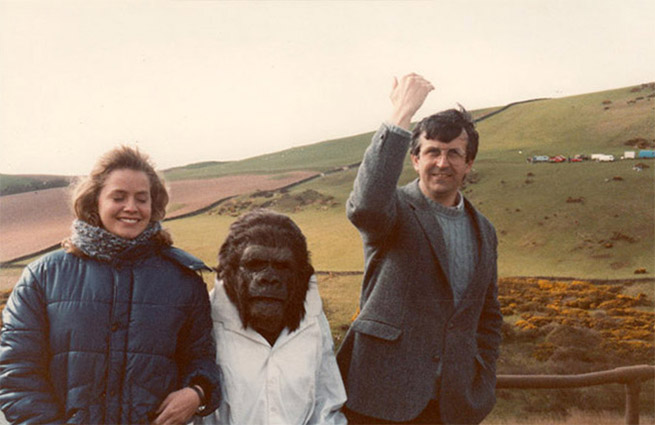 |
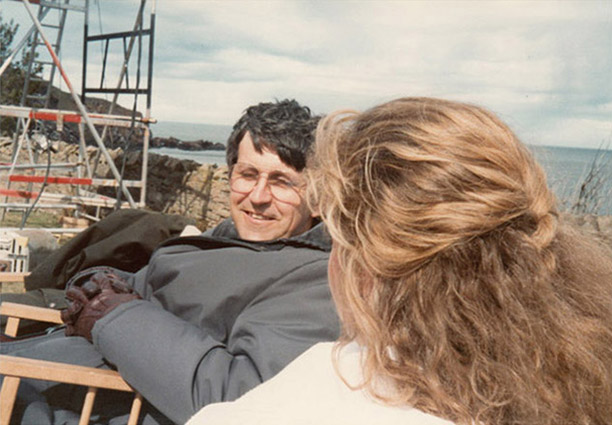 |
| Elizabeth 'Lisa' Shue, 'Jughead' and Richard Franklin |
Richard and Lisa (right) |
Despite Richard not being with us anymore, I will not be revealing the more salacious stories despite their obvious entertainment value. Even in death, there is a line I’m not prepared to cross. But it is no secret to say that from quite early on Rick and Richard (both co-producers) discovered that they both held different views on making films. Ironically it was Australian Richard who adhered to the American method and American Rick who’d eased into the British way. The Brits have a pretty good worldwide reputation, which is why Hollywood fills our studios up year after year (that and the tax breaks). Rick wanted to keep the crew sweet. Richard wanted the crew to work faster. This put both men on different paths that took them far from each other. Guess who was standing in the middle? I have day-to-day paragraph-long diary entries so can claim some aided recall even if it’s only from my own perspective. I’m not that witless to think my role in all this mattered a jot but there came a point in production where I had to make a choice; alienate the man who had supported me and got me the job or abandon the man I was hired to assist… That was a tough one. Rick had no qualms in trying to get me on his side and a part of me thought that I could still play neutral. If I met Rick today, I’m sure the water under that particular bridge would be just that and he’d remember a few happy memories of my brief role in his life. He certainly made my entry into the film industry as colourful as it could be and I owe him a debt for that alone. I made enormous ‘thank you’ cards for both Gavin and Rick after Dream Child wrapped production. This was in the age of Pritt stick and Letraset. I’d like to think they’d been appreciated at the time.
But here I was, assisting Richard who had lost the support and confidence of the crew (who were all effortlessly charmed by Rick). Richard had just come off two US features and was used to the god-like status directors enjoyed in Hollywood. British crews are a little less awestruck.
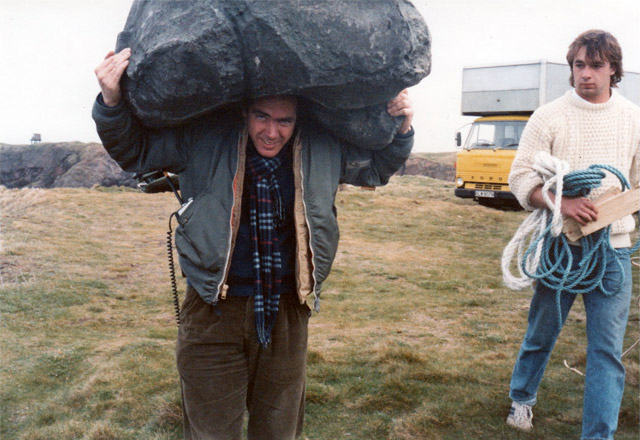 |
 |
| Rick M. with squishy 'rock' to f all on to |
Sarcastic dissent from the crew after enforced overtime |
The crew weren’t terribly pleased at being judged ‘slow’ by their director and pointedly let him know this with a banner printed with the words “We want to work on! We love hamburgers! You can’t do enough for a good Guvnor!” If Richard was affected by this very British mutiny, he never discussed it with me. He was frustrated beyond words by the ‘British Tea Break’ when he was trying to barrel through twice as many storyboards and set-ups required than on his other movies. After reviewing Road Games I feel like I may be seeing Richard in a different light, someone with excess faith that he could successfully chew what he had bitten off. How large those mouthfuls had been is open to fierce debate.
Relationships clashed beyond Rick and Richard’s contretemps, and I tried hard to be the support he needed while mounting problems added extra thorns to the stem of the rose I was grasping. I was once in possession of information that flatly contradicted Richard’s reading of a situation and could neither ‘correct’ him nor let him flail in the prevailing wind. I ended up making things much worse by prevaricating with even poorer results for both of us. But Richard was kind and patient with an inexperienced 24-year-old assistant and he passed on a lot of knowledge and experience. He ignited within me an appreciation of the work of Stephen Sondheim and even let me ‘direct’ a scene in Link. I refused the offer. Richard wholeheartedly agreed with my refusal once I realised he meant merely shouting ‘Action!’ and ‘Cut!’ When I said that I would be happy to direct one shot if I had full access to the actors, control over any script changes and permission to specifically direct DP Mike Molloy, Gale the camera operator and change the lighting. I think Richard might have reinterpreted his own generosity in involving his assistants in the process but also how his well-meaning benevolence might have been a little patronising in reality. At least I hope that was his take away from my refusal.
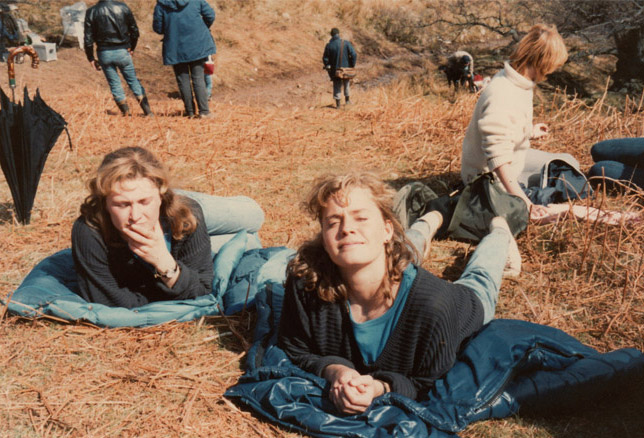 |
 |
| Tracey Eddon (stunt double) and Lisa |
DP Mike Molloy and Richard |
But while Rick’s relationship with the crew strengthened (and an on set fire effect managed to noticeably burn Rick’s face), I doubled down with Richard and we slowly formed a bond that continued and strengthened via frequent emails until his death in 2007, which I wrote about here. Rick and I never really built on our relationship after Link. We were geographically challenged and the role of ‘assistant to the director’ – very different from the roles of ‘assistant directors, one, two and three’ - was at the director’s behest not the producer’s. So while many of the crew followed Rick working next on Nic Roeg’s Castaway (how I would have loved to have assisted Roeg), I found myself out of work. But I was with Rick when he introduced himself to George Lucas (what a fateful day for genre filmmaking that was). I can confirm that Lucas was not extrovertly forthcoming as a person but Rick more than made up for that deficit in Lucas’s own personality. The team of Lucas and McCallum was much more a match made in a galaxy far, far away than the Potter/McCallum one. Or so it seemed to me at the time.
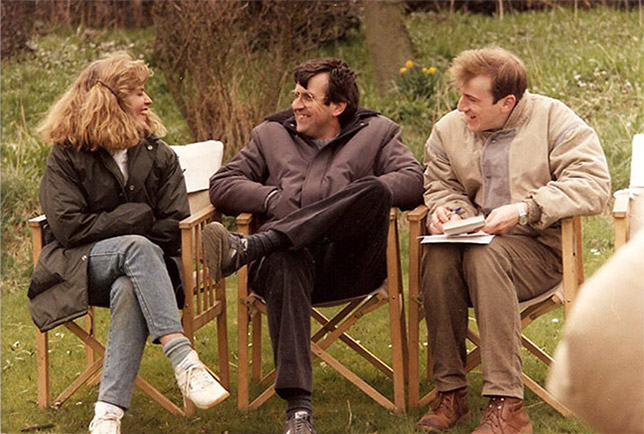 |
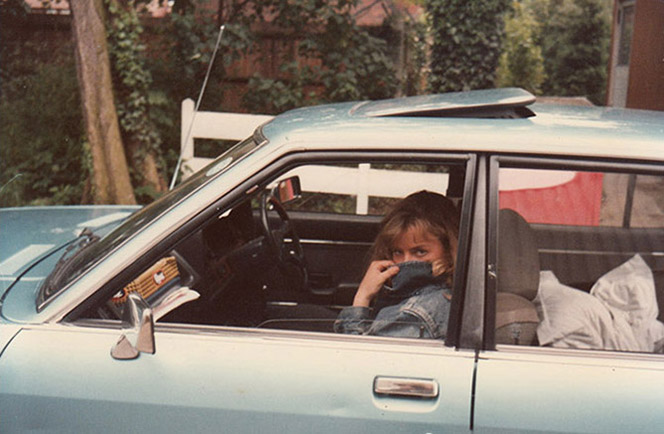 |
| Elisabeth 'Lisa' Shue, Richard Franklin and yours truly |
Lisa in playful mood after a day's shooting |
Elisabeth Shue (‘Lisa’) and I were contemporaries separated by a mere two years and we both recognised that we had similar points of view on the world and the maelstrom of insanity that is the average movie set, though from vastly different perspectives. I remember a lot of intense, philosophical conversations, a Scientology questionnaire that we both took and laughed about hysterically and finally a visit from her brother Will (who gave me the seal of approval to look after his precious sister while she was in the UK). Will died in a tragic accident a few years later while the Shue family was on holiday, an event that unsurprisingly affected Lisa profoundly. It was at this time she appeared in the Back to the Future sequels. Looking back at my diary entries of the time, my days seemed to be full of Indian takeaways, vodka, away days to London and lots of conversations with Lisa on every topic under the sun. I remember our ‘awfully big adventure’ on Link with great and lasting fondness. Bless you, Lisa.
 |
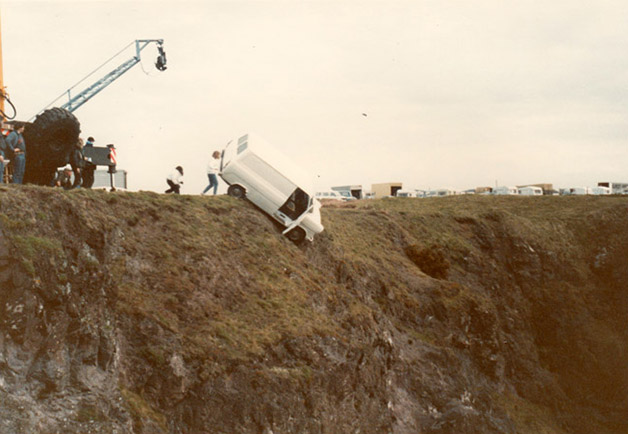 |
| Rona with one of her chimps |
Jane barely makes it out in time... |
We couldn’t shoot our US simian stars on location but we could get lookalikes trained enough to do basic outdoor ‘acting’. So while Jed (Imp) luxuriated in A-List accommodation at Shepperton, the famous UK chimp trainer Rona Brown supplied us with Imp’s double for exterior sequences. Apart from getting obligatory rabies shots, the crew had to be taught how to deal with a potentially dangerous situation if one of the animals went rogue on set. So the basic rule was to freeze and let the handlers deal with the situation. To control a pissed off chimp you had to physically smother it until it calmed down. It was very dramatic. I have to insist that there was no cruelty or nasty persuasion to get the chimps to perform. Every shot I witnessed featured animals trained to do what was needed without harsh coercion. That was Ray Berwick’s gift.
 |
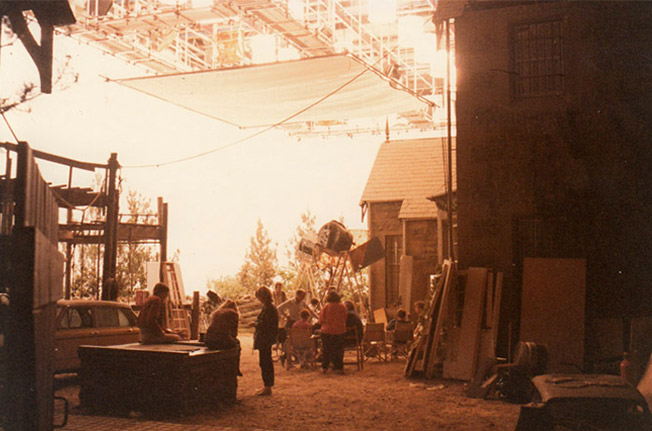 |
| Legendary animal trailer Ray Berwick (R) and company |
The crew at work on the Shepperton set |
I caught Locke’s eyes once as he sat high up in his own director’s chair. He looked back at me and made a clicking sound with a bite down. I did the same in response. In an instant, one of Ray Berwick’s two assistants put himself between me and the orang-utan and marched straight at me. “Alan, you just picked a fight with the star of this movie.” No more eye contact or clicking teeth. But if someone asked me to name a moment in my life where I witnessed a serious incident but was so tempted to burst out laughing, there is only one. I’m fairly sure that third assistant director Trevor would remember this with a little less amusement. I noticed that he wasn’t credited on Link because Richard had the assistant directors fired after a few weeks believing that this was all he could do to speed things up.
So here’s the set up. Trevor has a tray of coffees that he has to keep horizontal for obvious reasons. But those in need of refreshment are at the bottom of a cliff face and he has to steadily make his way down via a rope. OK, it’s not K2 but if he lets go of the rope, coffees or no coffees, it’s a long way down a forty-five degree slope. Imp’s double gets loose and the crew members freeze as instructed. Unaware that a powerful chimpanzee is now unfettered at the coastal location, Trevor continues his descent. If he had looked down he would have seen a frozen tableau of film technicians. I think Trevor was targeted by simply being the only one moving. Imp’s double was on him in an instant, thumping Trevor’s back and shoulders, small hairy wrists and fists reigning down. Bless his heart, Trevor kept those coffees horizontal as long as he could until someone shouted up at him that it may be to his advantage to ball up and to hell with the coffees. It was like watching someone holding a rope while a balloon takes them airborne and wondering how long it takes them to let go of the rope… To this day, I can still picture the sloshing of the coffees – not sure we used lids in the mid-80s.
After we wrapped in early July, I got together with Richard and Lisa for the ADR (automated dialogue replacement) then known as ‘looping’ and joined Richard for the recording of the score with Jerry Goldsmith (more on that experience in my obituary of that extraordinary talent here). It was two short, bittersweet endings to an experience that deeply and conclusively shaped me and my future in the film industry.
Presented in the 1.66:1 aspect ratio, Link here looks as good as it could look. Whatever source was used, it’s as clean as a whistle with immaculate hygiene exhibiting very little grain. The colours are vibrant and contrast levels are good across the board. Scotland looks gorgeous. The only time you can’t make out detail in the blacks is when the filmmakers wanted it that way. The stereo soundtrack has no intelligibility issues and delivers both score and dialogue with clarity and a hiss-free soundtrack.

There are English subtitles for the hard-of-hearing.
Just a short note about the main menu: The four main choices (Play Film, Scenes, Set Up and Bonus) are all coloured faint red and change to white once selected. Once you select Bonus, the word ‘on’ for the commentary is in white but it’s actually off (underlined in faint red next to it). It took me quite a while to figure this out. It’s the same with activating the subtitles via Set Up – if the ON is in white, you sort of think that means they’re on – but that’s just what you will change to its opposite if you select it). It’s mad, Ted. This of course could be my own brain just not understanding something very basic.
NEW Audio Commentary by Film Historian Lee Gambin and Film Critic Jarret Gahan
Lee and Jarret, early on in this commentary, discuss how much information they have to pass on and they suggest they may run out of movie. We at Cineoutsider appreciate good preparation. Obviously animal or monkey movies are up for discussion and I did wonder, based on their few behind the scenes comments, where they got their research from. As I’m in the very rare position of actually having been there when Link was shot, I’m tempted to correct a few exaggerations but then I remind myself of that famous phrase “Print the legend!” Let the legends stand! As in Sweet Charity, Lee’s commentary delivery is a hugely passionate stream of info and a great deal on similar monkey movies. A small confession; to get through the commentaries on Blu-rays, I sometimes play them at double speed. Lee actually talks at double speed! Trainer Ray Berwick gets a nod (scary bird stories). The significant bathroom scene is name-checked. If I’d bothered to do my research before I started working on Link, (no Google in 1985) I would have known that DP Mike Molloy was a camera operator for Kubrick and Nic Roeg. I would have prised a few stories out of him at the time. A missed opportunity. Jarret and Lee are a little dismissive of the ‘nameless teens’ that turn up to be slaughtered but they have a point. The classic voice of the Hollywood trailer is name-checked as is Diane Fossey. I’m almost certain Jarret meant Jane Goodall (Diane was gorillas, Jane was chimps). It always amuses me that the one woman more associated with monkeys in the world is really called Jane… Him, Tarzan.
Deleted workprint scenes (24’ 25”)
These comprise of the Cannon/EMI cut scenes as the film was shortened against Richard’s wishes. There is a mixture of content here, some shots no longer in the actual movie presentation and some scenes still in the film but showing here that they had been removed. The truncated/cut scenes are;
- Dr. Phillip’s Lecture.
- Dr. Phillip’s office – formal introductions.
- Jane catching the train north (not exactly saving money traveling first class, is she?)
- Taxi driver foreshadowing the Doberman attack.
- Jane at the house (a location zoom out reminiscent of Road Games’ similar shot at the coast).
- Jane getting physically examined as a lesson for Imp and Link.
- At dinner, eating and drinking while Link worries about a lit cigar that he has dropped and has been unsuccessful at putting out.
- Drunken Phillip barging in on Jane in her bedroom.
- Jane waking up and descending the stairs.
- Jane writing in her room, Link outside the door.
- Jane examining a book while trying to steer Link away from smoking.
- Phillip, post cognition test, explaining the abyss between man and ape.
- Jane burying Voodoo with Imp and Link.
- Jane leaving to get a car.
- Jane closing the kitchen door as Link tries to get in (with some extremely odd sound effects and a clearly hysterical Jane in ‘pongo-vision’). This was the term coined by Richard to describe the ape-point of view, which was a step printing process.
- Jane and Imp trying to flag down a trawler.
- Post fire, Jane helps David into the car and drives off.
Audio interview with director Richard Franklin (4’ 44”)
Delivering a few bon mots of dry wit, Richard rather forlornly talks about the fate of his anthropological thriller.

Jerry Goldsmith demo of the Link theme (3’ 05”)
I can’t really add much more to the title as far as information goes. It’s a non-orchestrated, sampled version of the main theme.
Theatrical Teaser (01’ 17”)
This is a scream. Did you know that an ape had “the speed and strength of an ape”? OK. Definitely aimed at the exploitation audience. It shows almost all of the film’s best moments, albeit in brief and you have to smile at the final line “We all have relatives we’d rather not talk about…” Classic.
Interview with Film Programmer and Horror Expert Anna Bogutskaya (20’ 16”)
Richard would have adored this feature. As I might have mentioned (haven’t written my memories of the shoot yet), before shooting Richard wrote his own review of a film he was about to start to remind him of the themes and ideas he’d wanted to get across. If the film failed commercially it was because (as Bogutskaya says) the film was too subtle as ridiculous as that sounds talking about a killer chimp movie. Richard packed many ideas into the film, which of course flew over the heads of a lot of people because as Bogutskaya reminds us, Richard was a cinephile and in some ways an intellectual. Editor and friend John Grover once said that in his opinion directors should be well read, as if the added knowledge gave weight and conviction to a storyteller. Richard took great pains to pack his films with all sorts of nods to the cinematic past but the one scene that Bogutskaya focuses on is exactly the key moment of evolutionary subtextual reading which was central to understand why Richard had taken the story on. It’s great to see a smart critic instinctively understand that about this particular film. And this is why the marketing could not promise what Richard was delivering. There are way too many syllables in the phrase ‘evolutionary subtextual reading’ and they are not words that work well on posters.
For a film I could not be impartial about even if I had my memories wiped, this has been a tough review to write. It’s like writing about an explosion while you’re being hit by the debris. This strange little thriller featuring one of the oddest murderers in cinema is nestled in to my heart too close for any objective opinion so I will just say if you like Richard Franklin’s work, prepare to be surprised by the oddest film of his oeuvre. Link is certainly underappreciated and this StudioCanal Blu-ray should win over the next generation of thriller/horror fans. Very warmly recommended.
* http://reflectionsonfilmandtelevision.blogspot.com/2015/01/my-interview-from-2005-with-link-1986.html
|